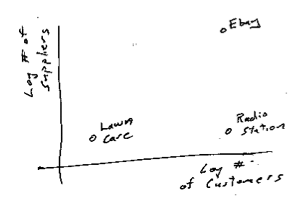 Zooming in on the landscape of the supply chain/graph we can make a very simple model of the firm. The firm has some skills which it plies by drawing inputs from suppliers and creating outputs for it’s customers. For example a lawn mowing business. On the supplier side a few employees, equipment suppliers, insurance, accountant, a bank, maybe a phone. On the customer side maybe a hundred customers. Not too much skill; mostly the skill of keep all these relationships functioning.
Zooming in on the landscape of the supply chain/graph we can make a very simple model of the firm. The firm has some skills which it plies by drawing inputs from suppliers and creating outputs for it’s customers. For example a lawn mowing business. On the supplier side a few employees, equipment suppliers, insurance, accountant, a bank, maybe a phone. On the customer side maybe a hundred customers. Not too much skill; mostly the skill of keep all these relationships functioning.
A demographer of this landscape might ask about numbers; then we could make plots to reveal patterns. For example consider the number of suppliers v.s. the number of customers. Some firms have huge numbers of customers but very few suppliers. When I was growing up there was a guy in my town who had this huge house on a small mountain; seemed he owned a single patent which he licensed out to companies all over the planet. Almost zero suppliers but millions of customers. Radio stations are another example of this kind.
 Then there are firms with huge numbers of suppliers and customers. A fast food restaurant chain for example has lots and lots of employees, real estate deals, local legal & political connections, on the supply side along with numerous customers on the other. Or consider eBay with it’s huge pool of sellers who supply it with goods and it’s huge pool of buyers who receive those goods. Or consider Google with its huge pool of content providers v.s. its pool of eyeballs searching for goods.
Then there are firms with huge numbers of suppliers and customers. A fast food restaurant chain for example has lots and lots of employees, real estate deals, local legal & political connections, on the supply side along with numerous customers on the other. Or consider eBay with it’s huge pool of sellers who supply it with goods and it’s huge pool of buyers who receive those goods. Or consider Google with its huge pool of content providers v.s. its pool of eyeballs searching for goods.
How is the population distributed over this two dimensional landscape? That’s actually two questions. Where are firms? where is the money? If we look at firms counts I suspect you find most of the firms are down toward the origin. First world households, for example, typically have maybe a hundred suppliers but they have only small integer number of customers – i.e. most 1st world people are full time employed. If instead of counts, you look at the cash flow I assume you find that much of it is further away from the origin; at least that would be consistent with the distribution of wealth.
See also: design patterns for intermediaries, Ping/Polling, etc.